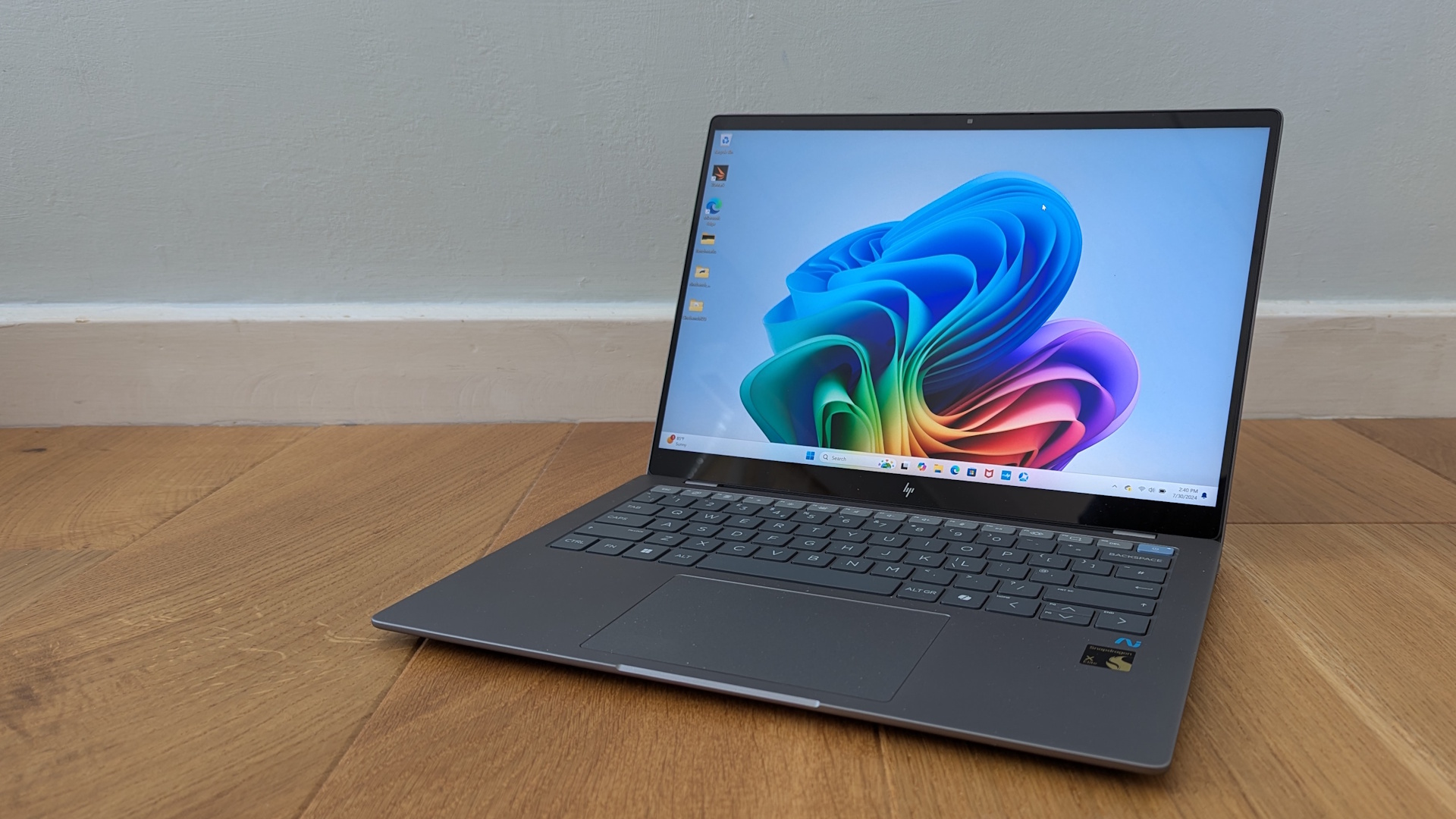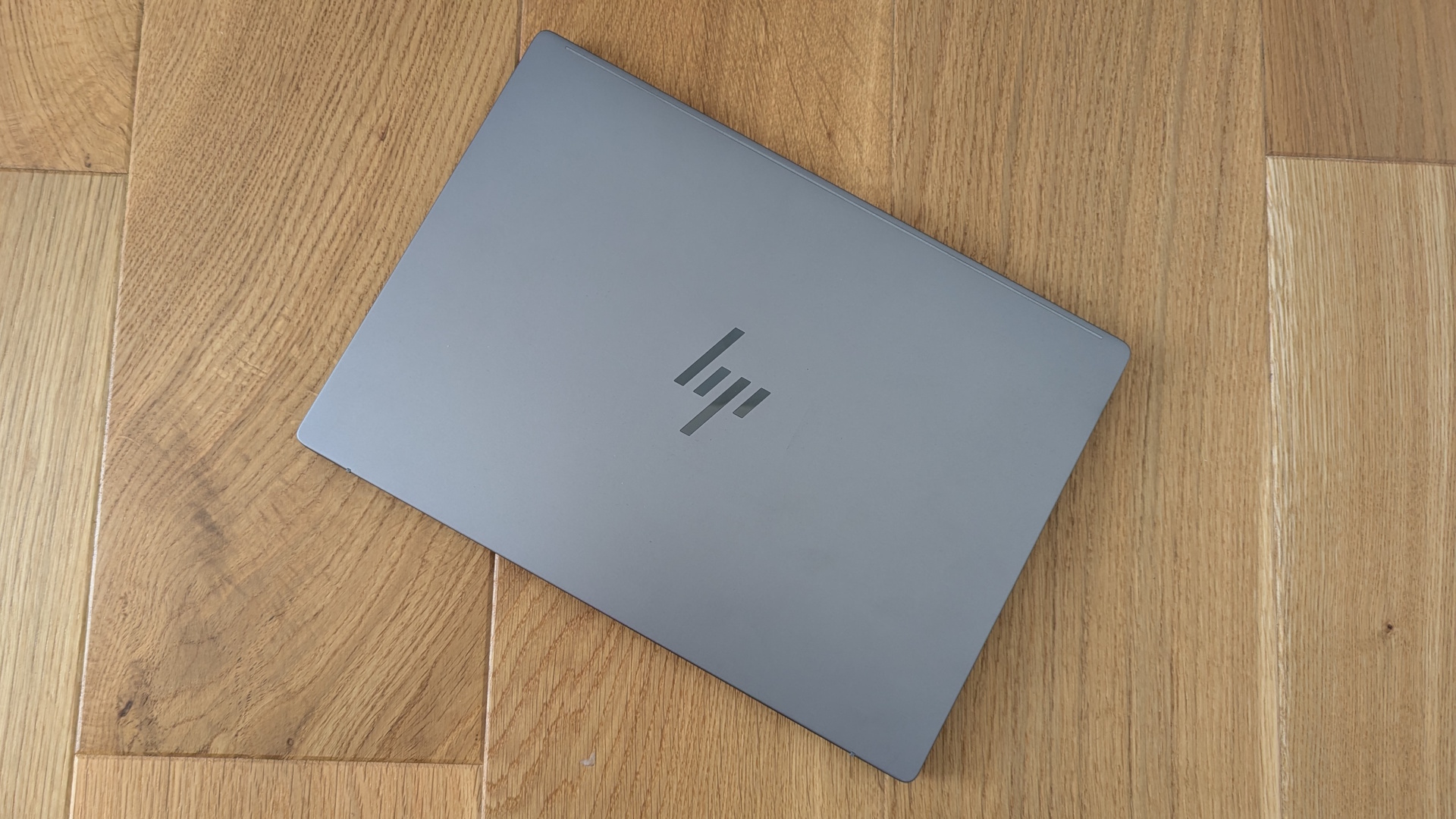HP OmniBook X 14 review: Incredible battery life meets Copilot+ AI
Ignore the slightly underwhelming screen and you have a brilliant thin-and-light laptop with AI capabilities and superlative battery life


-
+
Simple and understated slim design
-
+
Good all-round performance
-
+
Useful AI capabilities
-
+
Almost 20-hour battery life
-
-
Minimal physical connectivity
-
-
Screen should be brighter

The OmniBook X 14 is a big deal for HP, representing the first entry in its revived OmniBook brand since 2002, and its first Qualcomm Snapdragon X-powered Copilot+ PC. This isn't the first HP laptop to use Qualcomm's tech – you may remember the innovative faux-leather bound EliteBook Folio that launched back in 2021 – but the OmniBook X 14 is a far more mainstream proposition. And with the OmniBook line replacing HP's existing Pavilion and Envy laptop lines, it needs to be; like the Microsoft Surface Laptop 7 this is an AI-enhanced small business and consumer laptop, targeting much the same audience as Apple's M3-powered MacBook Air.
If so, the OmniBook X 14 is competitively priced. At £1199, The base 14-fe0001na version is £150 more expensive than the entry-level 13.8in Surface Laptop 7, but it uses the 12-core Snapdragon X Elite XE78100 processor rather than the 10-core Snapdragon X Plus, and has double the 256GB of SSD storage. A similarly configured Surface Laptop 7 would set you back £1449. Meanwhile, the equivalent MacBook Air, with an 8-Core CPU, 10-Core GPU, and 512GB SSD would cost you £1299, plus an extra £200 to upgrade the 8GB of RAM to 16GB. With a 1TB SSD and 16GB, our 14-fe0000na test sample comes in at £1299. As a value proposition, the OmniBook X 14 looks very tempting indeed.
HP OmniBook X 14: Design
It also looks very tempting in the flesh, thanks to an all-aluminum, slim-and-light design that only begs more comparisons with the new Surface Laptop and the MacBook Air. It's a compact 313 x 224mm unit not much larger than the 14-inch screen, despite a good 8mm of bezel above the display and 17mm below. It's just 14.4mm thick at the rear of the laptop, tapering to 14.3mm at the front. The aluminum shell seems seamless from the top, with the only ventilation at the rear and under the base. There's nothing spectacular or anything you haven't seen before, but it's going to look good anywhere from the living room to the boardroom, while the construction feels solid and well-engineered.
The downside of the slim dimensions is fairly minimal connectivity, with just two USB Type-C ports on the left-hand side and a single USB Type-A port on the right. What's more, only one of the two ports supports 40Gbits/sec USB 4.0 speeds, while the other is stuck on 10Gbits/sec USB 3.2 Gen 2. On top of that, one Type-C port will be required occasionally for charging. If you plan to connect to a desktop setup, you're going to want a USB Type-C dock. Still, HP wins a few points back for providing a rather neat slimline USB Type-C charger with a distinctive fabric-covered cable.

HP also gets a lot right with the keyboard. For one thing the layout is hard to fault, with large, well-spaced keys, decent-sized shift keys, and functional cursors in the bottom-right corner, even if these double up as the navigation keys. And while there's not a huge amount of travel, the action is crisp and fast. Meanwhile, the touchpad makes up for its limited area – 12.5 x 8cm is about as big as you can go on a laptop of this size – with excellent accuracy and responsive tracking. Anyone using the OmniBook X 14 as their daily driver shouldn't have any serious complaints.
HP OmniBook X 14: Display
If there's one area where the OmniBook X 14 falls slightly short, it's the 14-inch IPS display. There's nothing really wrong with it; the 2,240 x 1400 resolution gives you ample clarity and detail at this screen size, and color reproduction is reasonably good. It's capable of showing 99.9% of the sRGB color gamut, 76% of Adobe RGB, and 81% of DCI-P3. In my color accuracy tests, the average Delta E was just 1.55.
However, HP specifies a maximum brightness of only 300cd/m2, and in our tests, we recorded 290cdm/2. In isolation, in a room without too much bright sunlight, it still looks pretty good, but put it against other laptops in the same class and it's slightly dim. While it has the resolution of a £1,000+ laptop screen, the overall image doesn't quite match up. It's not a serious issue in everyday office work, but it can impact visibility when you're watching dimly-lit scenes in TV shows or films, and you might wish there was more zing if you're engaged in creative work.
Sign up today and you will receive a free copy of our Future Focus 2025 report - the leading guidance on AI, cybersecurity and other IT challenges as per 700+ senior executives
This is a shame, as the sound is surprisingly rich and powerful for a thin-and-light laptop, working well for both entertainment and video meetings and calls. We were also impressed by the output from the 1080p webcam, which provided clear and well-exposed video, particularly with the aid of the new Copilot+ PC Studio Effects for enhanced lighting and background portrait blurs.
HP OmniBook X 14: Performance
We've already seen from the Asus Vivobook S15 that the Snapdragon X Elite can be a formidable CPU, delivering impressive results across both single-core and multi-core benchmarks, and excelling in the latter. Here it's not quite so far, presumably as a result of the smaller form factor and a power profile that prioritizes low noise. Where the Asus's fans could be heard to kick in during demanding activities, the OmniBook X 14 barely makes a whisper.
In Geekbench 6, for example, the Vivobook scored 2427 in the single-core tests and 14337 in the multi-core. The OmniBook X 14 scores 2315 and 12585 respectively. In the Cinebench R24 rendering benchmark – the first to support ARM CPUs without emulation – the HP scores 87 (single-core) and 808 (multi-core) against 941 and 2804 from the Asus. To put this in perspective, though, this is still a fast machine. The Asus VivoBook Pro 15 OLED, with a Core Ultra 7 155H, scored just 12612 in the Geekbench 6 multi-core test, and nobody would accuse it of being a slowcoach.

As with the Vivobook S15, performance is slick and speedy in apps built to run on an ARM architecture, and more than good enough in apps running under emulation, provided they actually work (some notable applications including Adobe InDesign and Illustrator still don't at the time of writing). However, more demanding 3D applications, including games, can still leave the Snapdragon X Elite struggling. Where we'd expect to see a Core Ultra 7 155H scoring between 2700 and 3500 in the 3D Mark TimeSpy benchmark, the OmniBook X 14 scores just 1810. That also puts it a long way behind the Asus Zenbook S16 with its AMD Ryzen AI 9 HX370 processor, which scored 3725.
We're still experimenting with AI benchmarks, but in the Geekbench ML test the OmniBook X 14 scored higher than the VivoBook S15, with a score of 2914 to the Asus's 2804. All the same, it trails the AMD-powered Zenbook S16, which, with a score of 3308, is the top dog in this benchmark at the moment.
Still, the OmniBook X 14 reigns supreme in another crucial area: battery life. Running our standard video loop test it survived for an astonishing 19 hours and 27 minutes before dropping into hibernation, putting it ahead of even Apple's stamina champs. We suspect that more of us prize battery life over raw performance these days, and right now nothing can stay functional for longer without a recharge than the HP OmniBook X 14.
HP OmniBook X 14: Is it worth it?
Yes. While it doesn't perform quite as well as the Asus VivoBook S15, it's a slimmer, lighter laptop with incredible battery life. It's also fantastic value when you compare it to other laptops with a similar form factor, including the Microsoft Surface Laptop 7 and MacBook Air. The one thing that really goes against it is the underwhelming screen, but while it doesn't go as bright as we would like it to, the resolution and color reproduction aren't a serious concern. It might be an OLED panel short of greatness, but the OmniBook X 14 is an excellent buy.
HP OmniBook X 14 specifications
| Display | 14-inch 2,240 x 1,400 IPS, 60Hz refresh rate |
| Processor | Qualcomm Snapdragon X Elite X1E78100 |
| GPU | Qualcomm Adreno X1-85 |
| RAM | 16GB LPDDR5 |
| Ports | 1x USB 4 Type-C, 1x USB 3.2 Gen 2 Type-C, 1x USB-A 3.2 Gen 2 Type-A, r |
| 3.5mm audio jack | Yes |
| Camera | 1080p webcam |
| Storage | 1TB PCIe4 SSD |
| Connectivity | Wi-Fi 6E, Bluetooth v5.3 |
| Weight | 1.34Kg |
| Dimensions | 312.9 x 223.5 x 14.4mm |
| Battery Capacity | 59Wh |
| Operating System | Windows 11 Home |
Stuart has been writing about technology for over 25 years, focusing on PC hardware, enterprise technology, education tech, cloud services and video games. Along the way he’s worked extensively with Windows, MacOS, Linux, Android and Chrome OS devices, and tested everything from laptops to laser printers, graphics cards to gaming headsets.
He’s then written about all this stuff – and more – for outlets, including PC Pro, IT Pro, Expert Reviews and The Sunday Times. He’s also written and edited books on Windows, video games and Scratch programming for younger coders. When he’s not fiddling with tech or playing games, you’ll find him working in the garden, walking, reading or watching films.
You can follow Stuart on Twitter at @SATAndrews.
-
 LastPass hit with ICO fine after 2022 data breach exposed 1.6 million users – here’s how the incident unfolded
LastPass hit with ICO fine after 2022 data breach exposed 1.6 million users – here’s how the incident unfoldedNews The impact of the LastPass breach was felt by customers as late as December 2024
By Emma Woollacott Published
-
 OpenAI turns to red teamers to prevent malicious ChatGPT use as company warns future models could pose 'high' security risk
OpenAI turns to red teamers to prevent malicious ChatGPT use as company warns future models could pose 'high' security riskNews The ChatGPT maker wants to keep defenders ahead of attackers when it comes to AI security tools
By Nicole Kobie Published
-
 Oracle's huge AI spending has some investors worried
Oracle's huge AI spending has some investors worriedNews Oracle says in quarterly results call that it will spend $15bn more than expected next quarter
By Nicole Kobie Published
